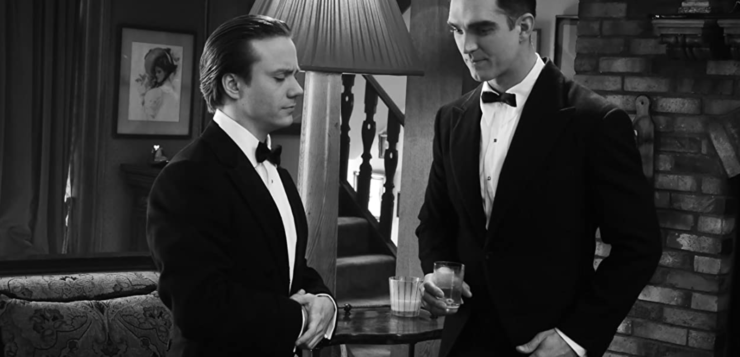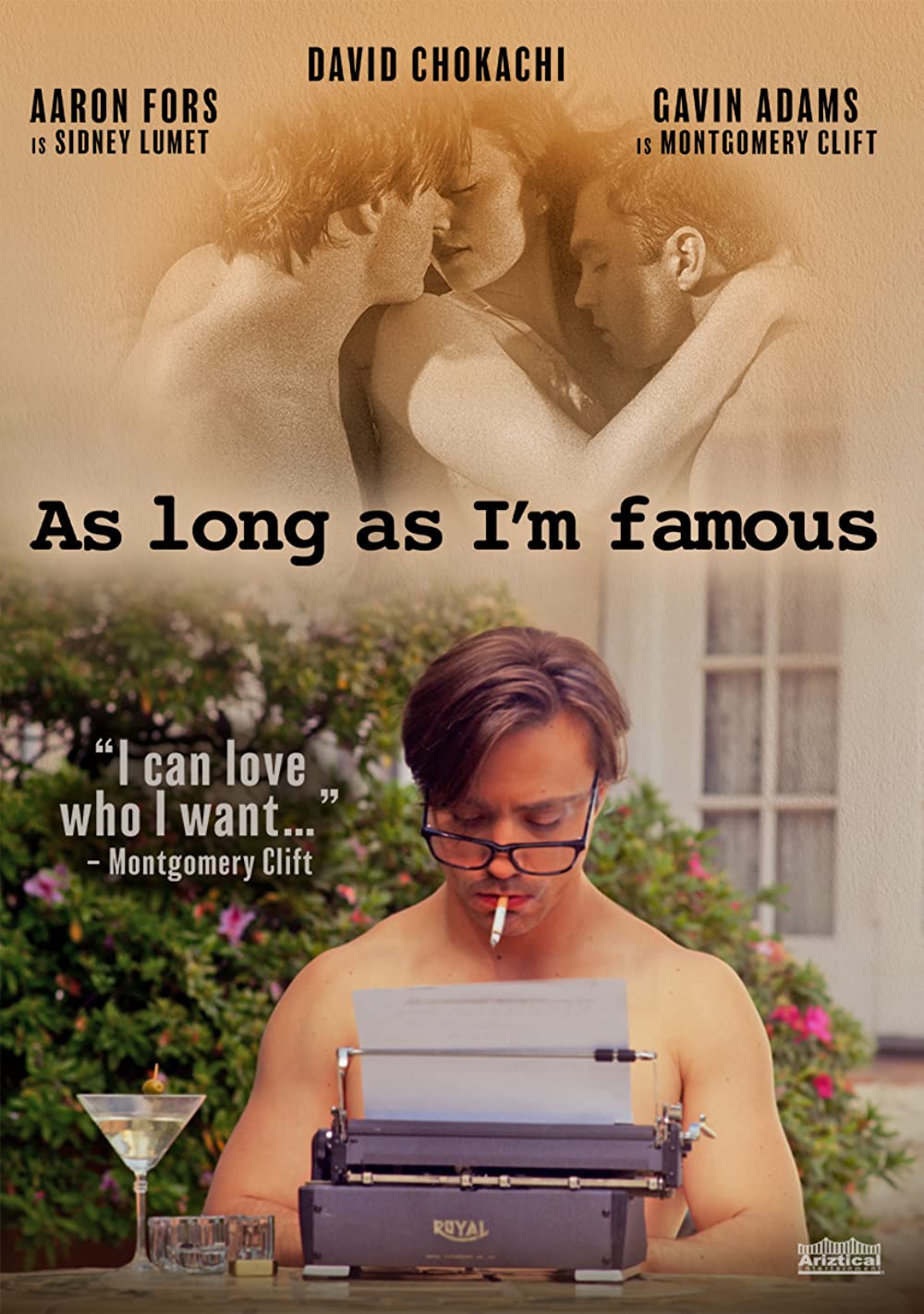The independent film As Long As I’m Famous, whose trailer was first released for streaming in 2020, and is available on Prime Video, as well as for rental on You Tube, but that is only the first confusion about this movie to which I confess. The film wishes to be an exposé of Broadway and Hollywood in the period after World War II; the narrative action mostly takes place in 1948. It focuses on a half-dozen overlapping relationships, but mostly zeroes in on the young Montgomery Clift after his earliest success in such films as The Search and Red River, and his friendship with the yet to be established television and film director Sidney Lumet, at the time working as an assistant to stage and film director Joshua Logan. Monty, played by Gavin Adams, is portrayed as essentially gay, although not unwilling to dip into traditional hetero waters. Meanwhile “Sid,” played by Aaron Fors, gently rebuffs Monty’s first entreaties, but despite Sid’s own ambiguity, he eventually gives into Monty’s blandishments.
It is hard to ignore an early screen title telling viewers that the story is inspired by real events. This accounts for immediate uncertainty, if not bewilderment. No one who has read Patricia Bosworth’s biography of Clift is likely to take this or anything else at face value. For one thing, I had no recollection of Lumet making any appearance in Bosworth’s narrative; I checked the index, and he is not listed. We might chalk this up to Bosworth being unwilling to “out” Lumet all those decades ago while he was still alive; the inclusion of Lumet demands either more backstory and/or more specificity in the written portrayal. Fors, who struck me as an engaged and engaging actor, suggests little of what we know to be Lumet’s later public personae, including a somewhat dour Jewish New Yorker’s sense of social justice and aesthetic gravitas. (To say nothing of a long history of heterosexual marriages, four to be exact, which doesn’t by itself argue against sexual experimentation.) As for Gavin Adams as Monty, while suitably handsome and sexy, he doesn’t bring any of Clift’s tremulous live-wire psychodrama to his portrayal.
Instead, the multiple personalities who figure in the film’s narrative as friends and acquaintances of varying degrees, and including the Broadway composer Richard Rogers, the once famous silent screen siren Theda Bara, Joshua Logan’s beautiful but unsatisfied wife, Nedda, the former boxing champion Gene Tunney, and a blind girlfriend of Sid’s named only Hannah, force us to consider how exactly this crew of dissatisfied neurotics found themselves bound up, however tangentially, in Monty and Sid’s world. What is fact? What fiction? Members of the large cast are individually interesting, even occasionally compelling. I would mention David Chokachi as Gene Tunney, who looks good with a shirt off and brings alive Tunney’s essential masculinity without the effort showing. Tracy Nelson as the middle-aged Theda Bara, now working as a nurse, also brings credible wisdom and rue to her character.

But throughout the film, which is handsomely mounted for cinematography and art direction, we face anachronisms and the injection of false notes. Too much dialogue feels as if it’s written in italics, rendering too stagey the questionable “naturalism” of the mise-en-scène. Take, for example, an early moment when Fors’ Lumet talks directly to the camera—and to us. Or, after Josh Logan has attempted suicide, Tracy Nelson’s Theda Bara reassures visitors that he’s now “docile as a bit player.” Camille Montgomery’s Nedda Logan complains that “a Broadway wife leads a posthumous existence”—presumably excusing her later adultery with Gene Tunney. And Sid Lumet explains to Monty why it won’t ever be possible for him to be open about his sexuality: “You’re a movie star, Monty, and commerce trumps cock!” Billy Wilder and I.A.L. Diamond this ain’t.
We might consider these bon mots appropriate to the Broadway-Hollywood milieu of the film’s time and place, but so much else works against a genuine feel for the era. None of the background music fits the period and there is barely a moment in the film in which we see these thespians and Broadway hotshots plying their craft. One exception: a fine black and white sequence in which Sid, like Monty an acolyte of the Actors Studio, engages an anxious Clift in a staged boxing match shot as if in a “film noir” movie. The match is to be a means to help Monty find the core psychological struggle taking place between the main characters, Catherine Sloper and Morris Townsend, in the film of The Heiress in which Clift’s role as Townsend is that of an ambitious but poor suitor to the well-bred and financially secure Miss Sloper. This little film-with-the-film takes us out of the movie’s frame and into an event staged to elucidate the main characters of The Heiress, a retelling of Henry James’s Washington Square.
But a central problem in As Long As I’m Famous is the claustrophobic and internecine world of its principal characters whose motives are a mystery to themselves and to us.Toward the movie’s denouement, there is a jump to 1956, with Sid and Monty walking in the hillside scrub surrounding Los Angeles.This follows the off-screen car accident that destroyed the gorgeous symmetry of Monty’s face.We get a brief glimpse of that damage; I am convinced it would have appeared vastly worse.Yet it suggests a new set of challenges for the ultra-sensitive Clift, who would go on to give durable and noteworthy performances in his late films—this, while living with frequent pain medicated with alcohol.Leaving Monty at just this point, the moment of his greatest challenge, suggests that a quite different film might have shifted the time frame and dealt forthrightly with heartaches just around the corner.But then, the filmmakers would have needed to cast someone to play Elizabeth Taylor, among Monty’s closest and most loyal friends, whose documented generosity would have forced a reckoning with undisputed facts.
Allen Ellenzweig, a longtime G&LR contributor , is the author of the recently published book George Platt Lynes: The Daring Eye.








Discussion1 Comment
Really superb review.